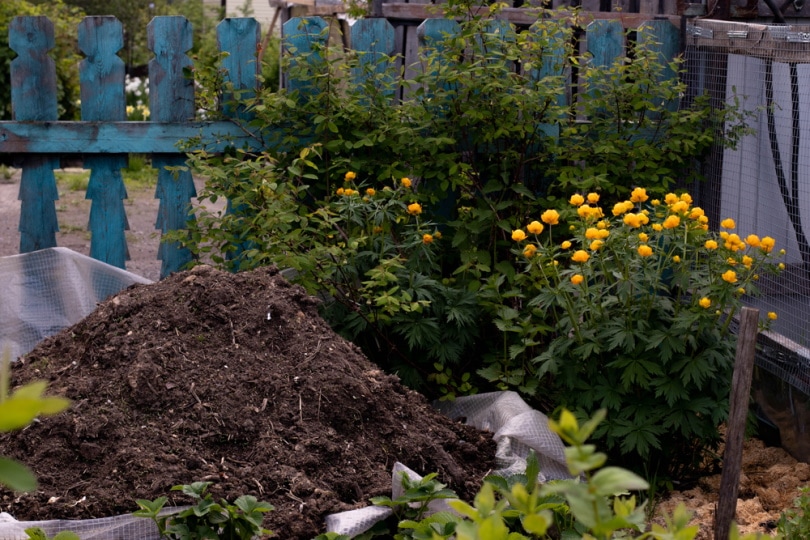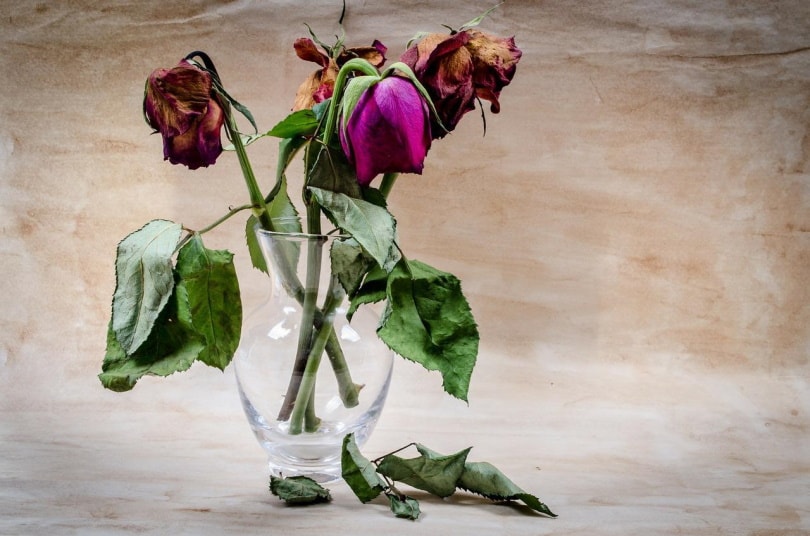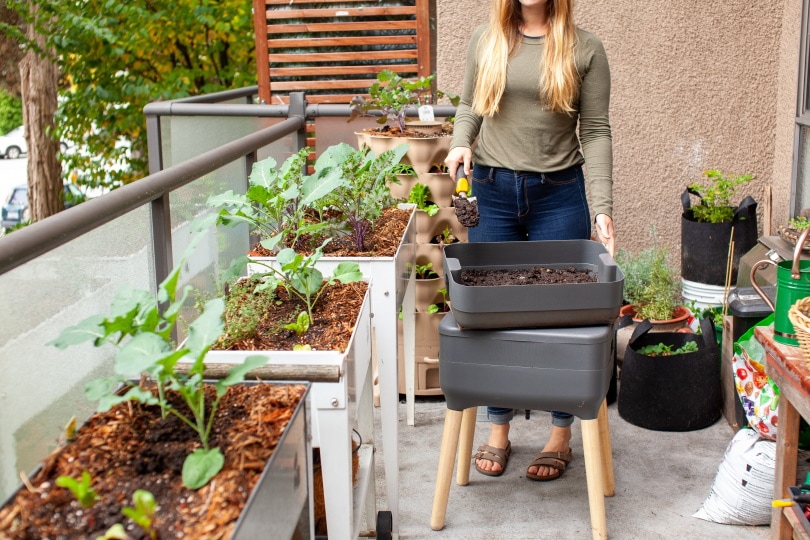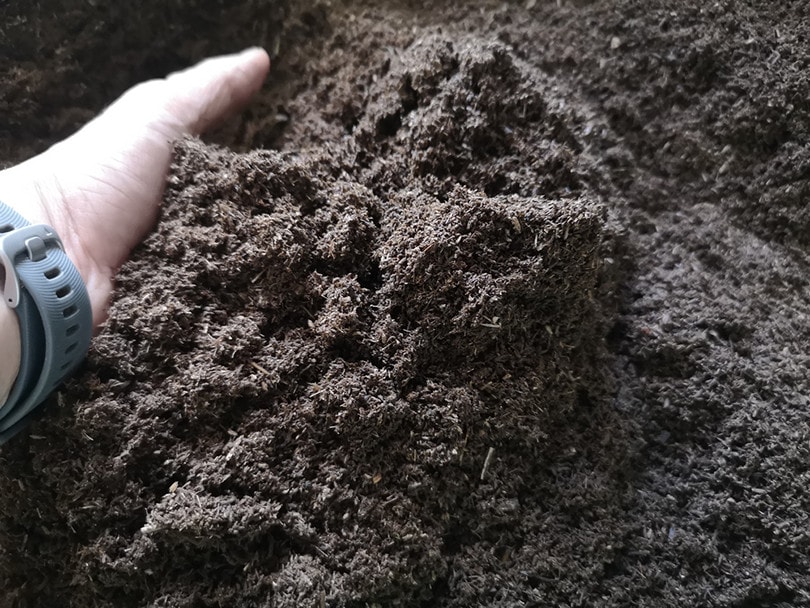Can You Compost Flowers? Facts, Tips & How to Guide
-
Pete Ortiz
- Last updated:

Have you ever had a heap of unwanted flowers from your garden and weren’t sure what to do with them?
Well, flowers are excellent ingredients for compost. Whether fresh or dry, it’s okay to compost flowers. You can add them to other ingredients like grass clippings and leaves on a compost heap.
This article looks into composting flowers. Get to know how it’s done, which flowers not to use and what to do with dead ones.
Adding Flowers to Compost
Flowers are part of plants, so it’s quite okay to add them to the compost. They are examples of organic materials that you place in a controlled environment for some time.
Composting entails using green and brown materials to make organic fertilizer. The green materials include kitchen and yard scraps that aren’t dry. Flowers are a perfect example of green waste that’s suitable to add to a compost bin.
It’s even possible to use flowers that you bring home from a florist. For instance, if someone gives you flowers, after a few days, you can toss them into the compost. These flowers are still green waste; however, be sure to remove any inorganic materials like wrappings and ribbons.
When you want to add the flowers to the compost, you can use some garden shears to cut them into smaller pieces. These will take less time to decompose and create the organic compost you need. Still, it’s perfectly okay to toss in whole flowers when cutting seems like a long process.

Can You Compost Dead Flowers?
While green flowers are a good ingredient for compost, does the same apply to dead ones? Well, instead of tossing dead flowers into the trash bins, you can add them to your compost.
The only difference between the fresh and dead flowers is their categorization in the compost. Because these flowers are dead, you can make them part of the brown ingredients you add to the bin. They are dry, so they don’t have enough moisture to be considered green.
Still, it’s possible to argue that dead flowers are still green when added to compost. This isn’t wrong but consider the fact that these are dry. But dead flowers can also be considered as a mix between green and brown, which even makes them an excellent choice for composting.
It’s also possible to compost dead flowers on their own. Since they are a mix of green and brown, they have the capacity to turn into compost by themselves. You won’t need to add any other ingredients to the bin or pile to get the organic fertilizer.
All you need to compost a heap of dead flowers is some lime and water. Water brings moisture to the mix, which is necessary for rotting and composting.
Lime, on the other hand, neutralizes acids that form during decomposition. Flowers tend to have more acidity, especially when they start to rot. This can affect the process of rotting that takes place when making compost. Lime plays a crucial role when you want to compost dry dead flowers.

Are There Flowers That Shouldn’t Be Composted?
Composting is a delicate process that requires extra care to get the best results. While it is possible to compost flowers, not all of them fit the bill.
For example, consider the dead flowers that you want to add to a compost pile. Find out why the flowers are dry and dead in the first place. If you notice this is because of an illness, throw them in the trash bin.
Never add any diseased flowers into a composting pile because that will bring you issues later. The sick compost can end up infecting your entire garden when you apply the compost.
In addition, steer clear of any flowers with lots of thorns on the stems. It’s better to even take off those thorns from your rose flowers before tossing them into the compost. Thorns can take up to 2 years to decompose—time you might not even have.
Also, it’s better not to compost commercial flowers that might have lots of herbicides and other chemicals. While these are green plants that suit a compost pile, the chemicals can be quite toxic. Decomposition won’t get rid of them, and this can affect your plants after using the compost.

Are Poisonous Flowers Compostable?
There are many examples of poisonous flowers that carry some deadly toxins. Usually, it’s better not to handle these flowers. But if you must, do so with care.
When it comes to composting, you can compost poisonous flowers without any worry. The toxins that these flowers have aren’t external like herbicides. So, when decomposition takes place, even these toxins get broken down.
All you need to do is gather the poisonous flowers and cut them into pieces. For this process, you need some protective gear to cover your skin, hands, eyes, and face. The poison from these plants won’t contaminate the compost, so they’re perfectly okay to use.
How to Make Compost from Flowers
Making compost at home follows several easy steps as seen below.
1. Gather your Flowers
Like any other compost pile, you have to get the ingredients before you start composting. Check the flowers that you want to use and pinch off any buds. Also, get rid of thorns because they take too long to compost. You can use fresh or dead flowers to make the compost.
2. Cut the Flowers
While it is possible to compost whole flowers, smaller pieces are more suitable. So, fetch some garden scissors and slice the flowers into smaller pieces. These will take less time to decompose in the compost than whole flowers with thick stems. Plus, you won’t have such a hard time when turning the compost.

3. Create a Composting Pile
Fetch the flower cuttings and start piling them like you would a sandwich. Ensure you have some brown matter to add to the compost pile. Even dead flowers are excellent. Add a layer of green matter like fresh flowers followed by brown materials.
4. Add Water
With each layer of ingredients that you add to the pile, pour some water. Water speeds up the decomposition process. But ensure you don’t overdo it since this can affect the rate and outcome of the compost.

5. Turn the Compost
Creating the best compost goes beyond having the right materials and piling them in the correct order. You have to keep checking the compost and turning it for effective decomposition. This is the best way to ensure bacteria in this pile work on those ingredients to create healthy compost.
6. Use in the Garden
After you have some healthy compost at hand, it’s time to add it to your plants. You can even start by adding the compost to the soil before tilling. This enriches the soil and gives you a healthier crop each season.

Tips for Composting Flowers Successfully
Creating the perfect compost can bring you a bumper harvest. So, when making your next pile using flowers, here are some tips to help you out.
- Work on Balance: The best compost requires a balance between green and brown matter. This is true even when you want to compost flowers. Check on the ratio of fresh green flowers and dry ones or any other brown matter you want to use.
- Keep Turning the Compost: After you pile the ingredients and close the bin, that’s not the end of your duties. You have to come back now and then to boost the oxygen supply to the compost. The best way to do so is to turn it. Bacteria in the pile that is responsible for decomposition need oxygen.
- Keen an Eye on the Moisture Levels: When making compost, you have to moisten every layer that you add to your pile or heap. After decomposition starts taking place, keep an eye on this moisture level. This is easy to do as you turn the compost. If the compost is dry, add some water to it. To check the amount of water on the compost, take some on your hands and wring it. If no water comes out, the compost is too dry. If lots of water comes out, it’s too wet, and you need to stop adding more water to it.
- Cut the Ingredients: Adding whole ingredients to a compost heap is okay. However, this means you have to wait a long time for decomposing to take place. It’s better to speed things up by cutting the ingredients into smaller pieces. This applies to both the green plants and brown materials you want to use.
- Divide Piles: Having lots of ingredients is a good thing. It means you can make lots of compost to use in your garden. But it’s better to avoid heaping all these ingredients together in one pile. That will take ages to decompose. Instead, divide the ingredients and create multiple piles, which will take less time to form fresh compost.
- Use Some Activators: Adding a layer of activators is essential when composting flowers or any other ingredients. Activators are rich in nitrogen and protein that the bacteria need when breaking down the compost ingredients. A good example of an affordable activator is Alfalfa meal.

Conclusion
Flowers are amazing, but at times you might have some that you have to get rid of. Instead of throwing them in the bin, add them to your compost pile. It’s good to compost flowers since they are part of plants. Fresh flowers can be green matter, while dead and dry ones belong to the brown pile.
When composting flowers, it’s better to avoid using those with too many thorns. Also, don’t use flowers that have been treated with herbicides and insecticides. Poisonous flowers are good to use since the toxins get broken down during decomposition.
See also:
Featured Image Credit: darydd, Shutterstock
Contents


